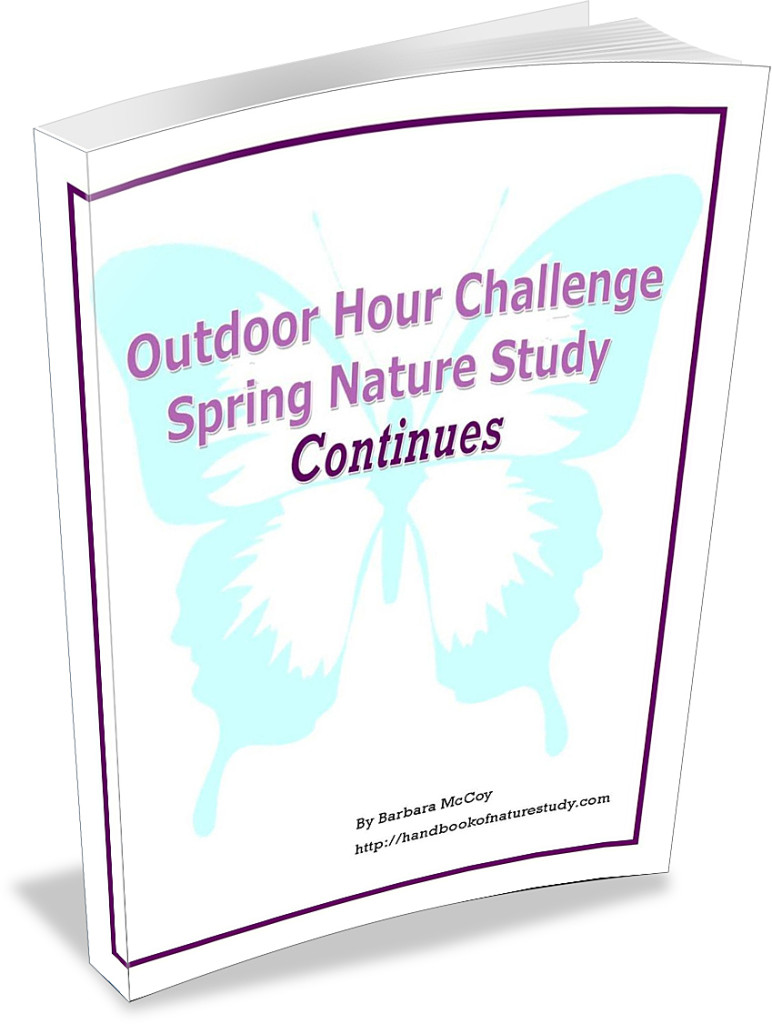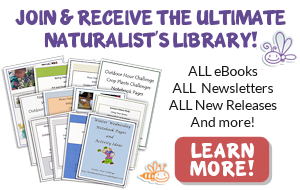- 13 new challenges centered on the Handbook of Nature Study
- 40 notebook pages (regular and advanced options) and 16 coloring pages
- Thirteen Charlotte Mason style exam questions
- Full color images for 10 challenges in the ebook (separate pages so you can choose whether to print them or not)
- Complete instructions for each challenge included additional links, videos, and resources
- Nature journal suggestions
- Complete list of supplies needed
- Sample to view: Outdoor Hour Challenge Spring Nature Study Continues Sample
- 90 pages in the ebook!
Here is a list of the specific challenges included in this ebook:
- Spring Peepers
- Jack in the Pulpit
- Yellow Ladies Slipper/Yellow Adder’s Tongue
- Trillium
- Bluets
- May Apple
- Newt
- Petunias
- Geranium
- Nasturtiums
- Black Swallowtail
- Crayfish
- Mountain Laurel
I am happy to announce the release of the long awaited Outdoor Hour Challenge Spring Nature Study Continues ebook! I have been so inspired to start some spring nature study while writing up these challenges for you and your families. You are going to enjoy the flowers, amphibians, and insects included in this spring series of nature study topics.
Special for this week only: Use the code SPRING5 and you will receive $5 off an Ultimate Membership!
Which edition of the Handbook of Nature Study do I need?
You will need to have a copy of the Handbook of Nature Study to use with the suggestions in the ebook. You can purchase a copy from Amazon.com or you can use an online version. The version of the Handbook of Nature Study I use is ISBN 0801493846.
Each week I will be sharing one of the challenges here on the blog which means you can follow along without a membership if you subscribe to my blog. You can subscribe by entering your email address in the subscription box at the top right of my website. After you enter your name, you will need to confirm your subscription by responding to the email that will come to your inbox.
Where Can I Get The New Ebook?
This ebook will not be sold separately but will be added to the Ultimate and Journey levels of membership here on the Handbook of Nature Study.
If you are a member of the Ultimate or Journey levels here on the Handbook of Nature Study, you will find the ebook listed in your library after you log into your account. The ebook version available to members includes all of the notebook pages, coloring pages, and color images. I highly recommend purchasing a membership for all the added benefits for each and every challenge.
Special for this week only: Use the code SPRING5 and you will receive $5 off an Ultimate Membership!
Note: Coupon expires on 3/23/15!



I was delighted to see your study of the Trillium family of flowers. I live in the mid-northern part of Ontario – in an area where there are a lot of white trilliums. The white trillium is the Provincial Flower of Ontario. On my rural property I have many white trilliums and quite a few red trilliums (also known as Wake Robins or Stinking Johnnies,since they bloom early and also have strong smell), a few painted trilliums, and at least one yellow trillium. The white trilliums stay white for a couple of weeks, and then the petals start to turn a light mauve / purple as the flower starts to die. Often when people see them in that stage they think that it is another species of trillium. The major problem with transplanting or picking trilliums is that there is only one stem per plant, and on a mature plant the three leaves come out mid way on the stem, and the flower is at the top of the stem, a few inches above the leaves. When someone chooses to pick the flower, they also pick the leaves in order to have a long enough stem to put in a vase. However that means that the bulb of the trillium then has no leaves to continue to bring nutrients to the bulb – and there are only a few weeks that the leaves can be touched by
sunlight since the trillium blooms before trees leaf out and shade the spring wildflowers. It often takes the bulb several years of producing leaves, without a flower, until it has enough energy in the bulb to produce another flower. The next year’s leaves and flower are actually developed underground during the late spring and summer when the leaves are still on the plant. One year I had to transplant a few of my trilliums and there was already a short stem, with green leaves folded around a tiny flower on these plants, ready to sleep though the winter and then push up through the thawing ground when the snow melted in the spring. White trilliums and red trilliums are usually in fairly large patches, but the painted trillium has smaller leaves and a smaller flower with a red tinge on the petals and seems to grow in groups of two or three plants. The yellow trillium is quite rare in our area. We have a local woods that is a park and has a massive display of white trilliums and other wild flowers in the spring – usually mid-May. I have arranged for a visit there for the local school’s Grade Three students for the last ten years, and often a day or two later some of the children bring their families there to show them the spring flowers. The village supports the trip because we all hope that by giving the children a reason to like the park, they will want to protect the plants and trees and as they grow older.
I actually have a big note in the trillium challenge to NOT pick them and to enjoy them where they are as part of this nature study. 🙂